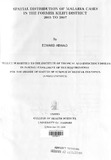| dc.contributor.author | Abwao, Edward | |
| dc.date.accessioned | 2016-06-23T05:59:08Z | |
| dc.date.available | 2016-06-23T05:59:08Z | |
| dc.date.issued | 2009 | |
| dc.identifier.uri | http://hdl.handle.net/11295/96294 | |
| dc.description.abstract | Background: Malaria prevalence varies between regions and even within the same region; there are variations depending on various Environmental determinants of malaria transmission. Kilifi district is located in the coast province of Kenya which is classified as a malaria endemic zone.The ability to identify areas with high spatial clustering of malaria is of great significance as it will enable targeted intervention to be employed in these areas to fight malaria. Spatial data analysis help identify areas with spatial clusters and also enable one identify trends that may be existing in the wider region. We try to see if there is any difference in malaria cases reported at the different types of health facilities. The study also tries to see if there is any difference in malaria prevalance in the population of under five years and those over five years. This study tries to find out the various sub regions where malaria is more clustered than others in district, based on the number of patients seen and treated of malaria in Kilifi district for the period 2005 to 2008. This study also tries to identify any spatial trends that may be present.
Methods: In this study, we examine the local distribution pattern of malaria using data collected between 2005 and 2007 from all the different types of health facilities located in the divisions within the district. These facilities were point-referenced. Continous spatial data analysis was then used to analyse the data.
Results: Malaria cases varies within the district and this can be seen from the different numbers in the different facilities. Analysis showed a significant association of malaria risk with elevation, humidity, rainfall. The resulting map broadly agreed with expert opinion about the variation of
risk in the country, and further showed marked variation even at local level. High risk areas were in the low-lying ocean shore regions, with the risk reducing as one moves away from the shores towards the high altitude region. Children under five years were at a much higher risk of contracting malaria as compared to those over five years. There was also no difference in the
number of patients who had malaria when analysed depending on the type of health facility they visited.
Conclusion: The map provided description of the geographic variation of malaria incidence in K'I'fi District- and might help in the choice and design of area specific interventions, which is crucial for reducing the burden of malaria in in Kilifi District and may be applied to the whole country. | en_US |
| dc.language.iso | en | en_US |
| dc.publisher | University of Nairobi | en_US |
| dc.rights | Attribution-NonCommercial-NoDerivs 3.0 United States | * |
| dc.rights.uri | http://creativecommons.org/licenses/by-nc-nd/3.0/us/ | * |
| dc.title | Spatial distribution of malaria cases in the former Kilifi district 2005 to 2007 | en_US |
| dc.type | Thesis | en_US |
| dc.description.department | a
Department of Psychiatry, University of Nairobi, ; bDepartment of Mental Health, School of Medicine,
Moi University, Eldoret, Kenya | |



